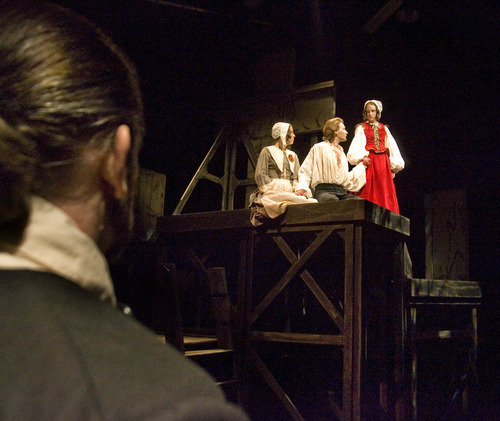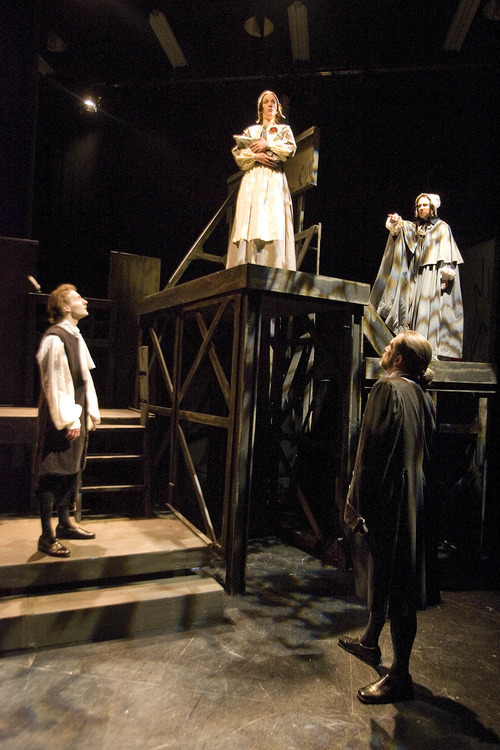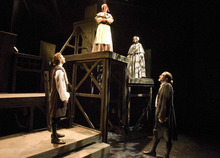This is an archived article that was published on sltrib.com in 2012, and information in the article may be outdated. It is provided only for personal research purposes and may not be reprinted.
Nathaniel Hawthorne wrote that after he read the second half of The Scarlet Letter to his wife, the story broke her heart. It also broke her head. "[It] sent her to bed with a grievous headache, which I look upon as a triumphant success," Hawthorne wrote in 1850.
Utah playwright Jenifer Nii said the play wracked her brain in a similar way when she worked for months adapting Hawthorne's prose into dialogue and stage directions. Fidelity to the novelist's text was nothing compared with the ways the book troubled her soul.
"I can't remember all the times I ripped out pages of the script to start over," Nii said. "I read the book once just to get familiar with it. Then it sank in really deep. The more I read the book and pondered on it, the more I saw The Scarlet Letter in the world."
The bane of almost every high-school student English class, Hawthorne's novel about the societal forces at work on a woman charged with adultery in 1640s Puritan New England is famous for posing the adolescent question of "What's the big deal?"
For Nii and most of the cast of Plan-B Theatre Company's production, the answer is everywhere. The political furor over women's contraception reminds us that men in power still feel compelled to speak about issues of women's choices regarding health.
We recoil at a law in Uganda requiring the death penalty for "the offense of homosexuality." International news bureaus describe the horrors of women raped, killed or disfigured when acid is thrown in their faces after they defy male suitors or their family's commands for arranged marriages.
"How does one group of people get to decide who's supposed to feel shameful or not?" Nii asked herself.
That question hovers above Hawthorne's 162-year-old novel like a black omen, along with current events that keep it suspended. But there's also something deeper at work than moving the characters of Chillingworth and Hester Prynne around a dramatic chess board as stand-ins for Rush Limbaugh and Sandra Fluke. Nii aimed to identify and retain as many of Hawthorne's original themes as possible in writing the adaptation.
That includes the pain of Dimmesdale's guilt, the austerity and resiliency of Hester and the bonds of parenthood between Hester and her daughter, Pearl. "You don't want to stray far from greatness," Nii said.
Plan-B's production, directed by Cheryl Ann Cluff, gathers some of the best in Utah acting talent. David Fetzer, who performed in Plan-B's "The Third Crossing" last month, plays Dimmesdale, with Mark Fossen as Chillingworth. Lauren Noll, who played Ophelia for Plan-B's production of Aden Ross' "Lady Macbeth," plays Hester. Playing Pearl is 15-year-old Claire Wilson, a student at the Salt Lake School for Performing Arts.
Pearl sounds the play's strongest notes at its opening, asking the audience directly who's fair to judge her mother. When Hester and Dimmesdale exchange words, during which Hester owns her sin, Pearl praises her mother's courage in the face of judgment.
"It's a book everyone needs to read at some point," Claire Wilson said, drawing parallels between the plot and the social claustrophobia and bullying of school environments. "You see people left on the outside of things in the same way."
As with all great stories, Hawthorne's book resonates because it offers so many interpretive angles, Nii said.
The most pressing question of the book —and Nii's adaptation — is whose crime is worse, Hester's or the Puritan community's. "Once that's answered, what is the impact on the soul?" Cluff said.
Fetzer said there's little evidence in the book that parallels ways and shame and judgment operate in contemporary society. Instead, he believes the story powerfully portrays how one woman survived when a community rallied against her.
"For me, it's about getting over the pain of confronting issues, and how that will make us happier once we confront them," Fetzer said. "No one in this play is trying to exonerate themselves in any way."
Cluff notes that the set design by Randy Rasmussen replicates the dramatic space of the story itself. It's black, to suggest a somber mood. It's compact, to match the claustrophobia of communal judgment. The Christian cross built into the woodwork speaks for itself. Even with all those elements united in the set, and fortifying the action onstage, Cluff wouldn't want anyone to think the play's all doom and gloom.
"It's easy to see it for all that," Cluff said. "But these are characters that rise above it."
Twitter: @Artsalt
Facebook.com/nowsaltlake —
Plan-B Theatre Company's 'The Scarlet Letter'
When • April 12-22. Thursdays and Fridays, 8 p.m.; Saturdays, 4 and 8 p.m.; Sundays, 2 p.m.
Where • Rose Wagner Center Performing Arts' Studio Theatre, 138 W. 300 South, Salt Lake City
Info • $10-$20. Call 801-355-ARTS or planbtheatre.org for more information.







